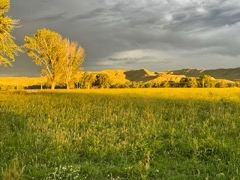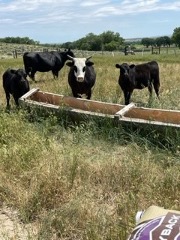Haying, Gated Pipe and Cows
#bfrdpwy #aginternship #RightRisk

This week, regarding irrigation, we continued and completed flood irrigation of a pasture to saturate the ground in an area the pivot could not reach. This irrigation entailed very quick dam sets to prevent water from running into the pivot tracks and deepening them through erosion.
I also learned a new form of irrigation this week that enlists the help of a structure called a “gated pipe.” A gated pipe works by sequentially opening square “gates” that release water relative to how much water pressure you have available. This is a very efficient way to irrigate a small area of land. I also learned how to cut, grind and drill through a metal pipe to create a mechanism on the pivot that will cause an automatic shut off once it hits a backstop.
The process of haying moved forward this week and I was able to observe how swathing, raking and baling is completed at any time of day to produce bales with high protein and low moisture content. I learned that hay should be below 25% moisture content before it is baled, which has been a difficult feat here due to the high humidity and precipitation levels.
Regarding cows, this week I continued to practice herding on horseback and learned you should place herding pressure on cows rather than calves because calves will follow their mothers, but lone calves will bolt in any direction, regardless of which direction you are pushing them due to a higher fear drive. They also tend to return to the last place they ate and hide to wait for their mothers to return if they are lost.

I continued practicing saddling on my own, tying a lead rope, tying up a horse to a hitching post and was able to watch one of our horses be shod with new horseshoes. I am looking forward to learning much more about the interactions between horses and livestock and how I can continue to improve upon my herding/horse-riding abilities.
I challenge the concept of grazing animals in an area that is extremely deteriorated and in drought. This is not something I observed at my current residence but, rather, at other ranches in the more southern part of the state that are facing extreme drought.
How do ranchers feed their animals sustainably in the face of extreme drought and limited plant growth? How will these ranchers feed their animals in the winter if they have nothing to [feed]hay without expending money to buy hay? What is the effect to their profit margin if they are forced to buy hay and even more dire, must feed hay in the summer?

What is the highest percent moisture content you can bale at? Why do some heifers have horns? Why are herds almost entirely female with only a few bulls? How do grazing habits change as invasive species of plants begin to spread/flower? Why do cows like to climb ridges where there is no food available? Why are black angus the most preferred breed of cow?
I plan to use what I’ve learned over this past week about the sequential steps of haying to learn how to drive a tractor. I am excited to use what I have learned over the past few weeks to become more hands-on in the haying process. I would also like to continue to build my knowledge base on horses, riding, herding techniques, etc. by progressively riding more.
Submitted by: Jamie Kaste
Edited by: GrowinG Internship Team

